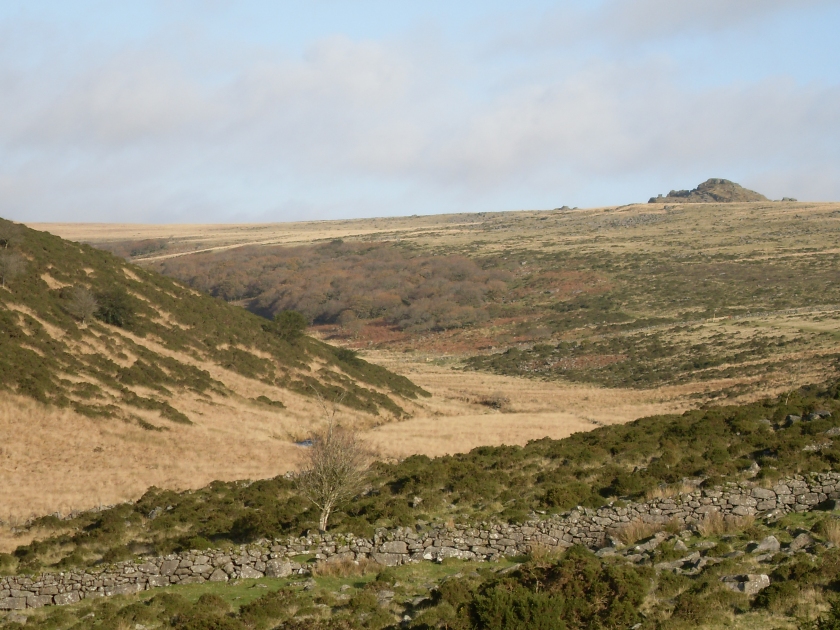
Just a look at some past blogs recent blog-watchers might have missed.
One of the best things we did in my time as chief exec. of the Dartmoor Preservation Association, was to pay for the restoration of the gravestone of William Crossing, author of the classic Guide to Dartmoor and many other works about the Moor. Before we had the stone in Mary Tavy churchyard re-lettered, it was hard to read. It was a job well done.
Crossing’s Guide to Dartmoor was first published in 1909, and it remains the most detailed book about the Moor.
(Note that: The Moor, with a capital M. While you may be in the Lake District, or the Scottish Highlands, you are always on Dartmoor. If you are in Dartmoor, it means you’re banged up in the prison – I never have been. They haven’t caught me yet! Though I have several times found myself within its precincts.)
Back in the 1960s, it was hard to get a copy of the Guide, until in 1965 David and Charles did an admirable reprint, with an introduction by Brian Le Messurier. Brian wrote introductions for several other Crossing books.
As a teenager with a Dartmoor obsession, I devoured the guide. Brian was sensible not to try to update the guide. It didn’t need it, Dartmoor hadn’t changed that much in sixty years, despite being Britain’s most abused National Park, and, as Brian pointed out, the result wouldn’t have been Crossing’s guide.
There’s not a bit of Dartmoor left out from the hundreds of walks Crossing suggests, or not that I’ve found. And his Hints to the Dartmoor Rambler chapter is one of the best thoughts on what you might encounter on your walks. The summary of ancient tracks is superb, giving further scope for moorland expeditions.
Best of all, Crossing caught Dartmoor at an interesting time, before the modern world got at it. When folk farmed in a traditional way, when old folktales were still being told around the moorland hearths, when antiquarianism was being transformed into archaeology.
William Crossing was born in 1840 and died in 1928. He lived a lot of his life in poverty, writing hard to keep himself out of the workhouse. In old age, crippled up with rheumatism, only the charity of friends kept him from poor relief. He did some desultory, badly-paid work for the Dartmoor Preservation Association, which hardly benefited him (I know the feeling!)
His contribution to the DPA’s work has never been properly appreciated.
I think back fifty years to the day I emerged from a Newton Abbot bookshop with my copy of the reprint. Now, though I collect guidebooks, I seldom follow routes in them, but I made up my mind that day to walk every single walk Crossing suggested – and I did, though it took several years. Interestingly, there were only a few where I had to improvise, where, for example, reservoirs had been built or conifers planted – I do wonder how many other Dartmoor walkers have done every walk in the book exactly as Crossing suggested?
In that period, everyone referred to the book simply as “Crossing”, such was its authority. I suspect most Dartmoor walkers these days hardly glance at it, which is their loss. There are some excellent modern writers of Dartmoor guidebooks, but none of the present generation come close to William Crossing.
I used Crossing’s work as written evidence in numerous Dartmoor campaigns, from fighting mining companies to preserving the ancient lines of footpaths. He remains an authority worth quoting.
When I quit the Dartmoor Preservation Association in 2005, it was suggested to me that I should write a topographical book on the Moor. I gave it serious thought and decided not to do it. How could I compete with writers like Crossing, or Richard Hansford Worth, a predecessor of mine at the DPA, who wrote fine archaeological essays about the place?
I may still write a non-fiction Dartmoor book – you might like to try my Dartmoor thriller novel Dangerous Game – but it won’t be a guide, more an autobiography of those days when Dartmoor was less crowded, when I explored the Moor in Crossing’s footsteps. I can’t compete with the great William Crossing.
I shall never do all those Crossing walks again, but doing them when I was young enabled me to get to know Dartmoor really well. A foundation which served me well in the years that followed.
So if you are near Dartmoor and want to get to know the place really well, find yourself a copy of Crossing’s Guide to Dartmoor, and start on those walks. It’ll take you a few years but, if you have the energy, you’ll know the Old Moor in a way that’ll be the envy of Dartmoor dilettantes.
And, if you do, I envy you the chance of following in Mr Crossing’s footsteps for the very first time
So Crossing was Dartmoor’s Wainwright – and then some!
LikeLiked by 1 person
Even more detail than AW, though prose not drawings. Still the best.
LikeLike
That’s like me in coursework and exams – I hate doing any kind of diagram so I just describe it in detail. It sometimes take a long time!
LikeLiked by 1 person
Cripes, better change my blog title to ON Dartmoor then! I did have a think before titling it… Thanks
LikeLiked by 1 person
To be honest, I didn’t notice. A wonderful place whatever.
LikeLike
I have the book and have just had a quick look at the walks section. I’ve done some or parts of them. Need a new Dartmoor challenge so maybe this could be it
LikeLiked by 1 person
Literally covers every part of the Moor.
LikeLike
I didn’t literally do them in order, as I wanted to sample all parts of the Moor.
LikeLiked by 1 person